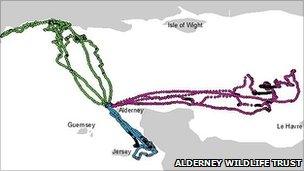Les Etacs gannets research reveals 340km feeding trips
- Published

GPS tags were retrieved from 17 birds, 72 hours after they were attached
Research into the feeding habits of Alderney's gannets has revealed they make frequent, long-distance journeys around the Channel in search of food.
Global Positioning System (GPS) tags were attached to the tail feathers of 23 gannets breeding on Les Etacs rock, just off the island's west coast.
They revealed one bird making a 340km (211m) round-trip and others making two journeys to England within three days.
Les Etacs is home to 2% of the world's population of northern gannets.
The research project is being run by Liverpool University with the support of the Alderney Wildlife Trust (AWT) and the British Trust for Ornithology.
Roland Gauvain, AWT's manager, said: "We're learning a lot of new information by doing this.
"You can't tell these details unless you're prepared to get in a boat and chase gannets," he said. "It's not practical. People don't do it."
Mr Gauvain said the birds were "going over to the UK, fishing and resting on the water overnight and then returning the following day while the partner probably goes out and feeds".
'Remote locations'
The tags were placed on the birds' tail feathers rather than the legs so as not to interfere with their ability to dive for fish at high speed.
They were attached to 23 birds on 6 June and after three days researchers were able to retrieve 17.
A similar study has been conducted on breeding gannets at Les Sept Iles off Brittany.
Results from these projects have revealed that the two populations' routes do not overlap.

The research showed gannets breeding at Les Etacs fed in different areas to those at French gannetries
Mr Gauvain said: "The Channel Island colony is really concentrating on the Channel Islands and across to the English coastline due north of us, whereas the French colony is concentrating out towards the Atlantic and the middle of the Channel and further along the English coast."
He said Les Etacs had been an ideal place to conduct the research, as it lies just a few hundred metres from Alderney and is therefore more accessible to researchers.
"Being that close to a mainland site is very unusual. Gannets like remote locations... so predators such as humans and rats can't access them."
Les Etacs is protected by a strong current known locally as The Race and is home to more than 7,000 breeding pairs.
The project was funded by the Alderney Commission for Renewable Energy, which is hoping the birds' behaviour will reveal more about the movements of fish populations in the Channel.
"They're feeding over large areas and not just in areas that might be developed for marine renewables by Alderney but also by Guernsey, Jersey, France and Britain," Mr Gauvain said.
The AWT hopes to conduct a further three-year research project at the Alderney gannetry in 2012 and the information gathered is likely to inform the designation of any Marine Protected Areas in the region.
- Published7 June 2011
- Published24 May 2011